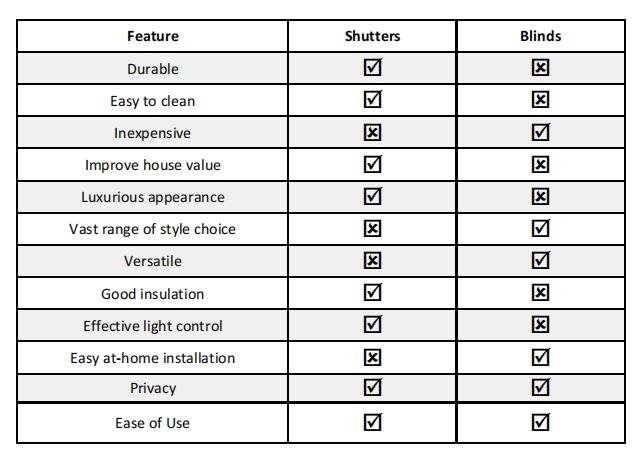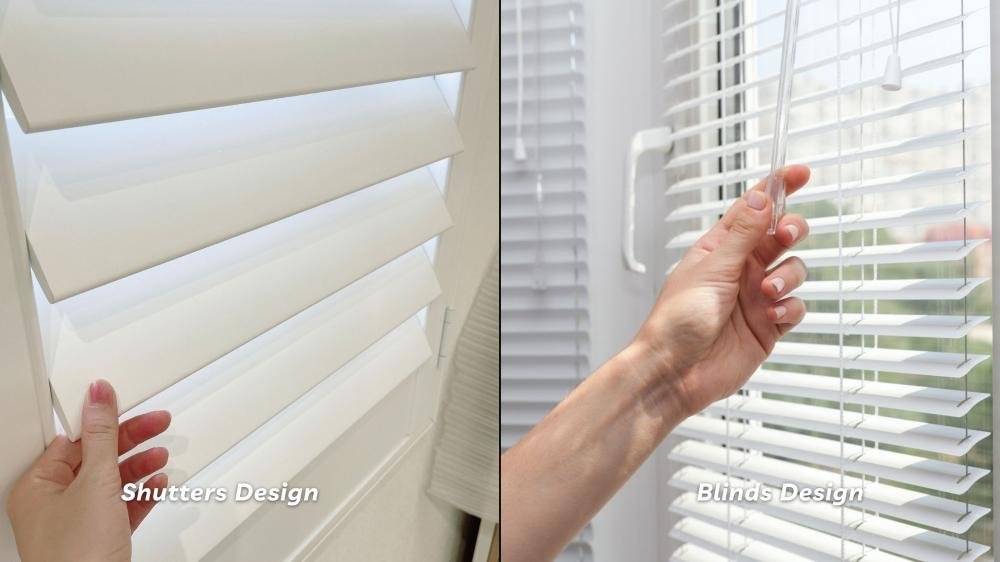
Plantation shutters and blinds contribute significantly to your home’s interior style. Personal preference, financial situation, and location determine which alternative to choose. This article can assist you in figuring out the price of plantation shutters and blinds, the advantages of both plantation shutters and blinds, and the best setting or settings for each window treatment. These straightforward recommendations can help you compare products.
What is The Difference Between Plantation Shutters vs. Blinds?
Shutters and blinds differ primarily in their structural design. Plantation shutters are made of solid materials that frame the window, such as wood or vinyl. They’re hinged on one side and open via a tilt rod at the middle or side. On the other hand, blinds either slide within an overhead track or attach to a head rail just above the window casing. Blinds can also be pulled up and down to adjust light levels easily.
Styles
The robust and sturdy construction and angled louvers of plantation shutters are prominent features. Homeowners can use these to regulate the light entering the building. For example, the shutter can swing open on a hinge, or the louvers can be moved in different directions (similar to a door).
Blinds exist in various designs with various control mechanisms, none of which must include louvers. Vertical options, for example, run on a track and are made up of vertical slats. The horizontal slats used by Venetians can be raised or tilted, typically using a string.
Materials
Blinds can be made out of: Natural Wood, Engineered Wood, PVC/Vinyl, Plastic, Metal, Synthetic Insulating Fabric, and Natural Fabric. However, shutters can be found made of natural wood, composite wood, PVC with a metal core, and aluminum.
Plantation shutters tend to do a better job of blocking light and limiting how much heat enters your home thanks to their more solid construction and thicker materials, which are essential for homeowners struggling with the summer heat.
Cost
The cost of shutters and blinds will vary depending on your chosen material, size, and features. Shutters tend to be more expensive due to the high-quality materials and craftsmanship that go into making them. However, shutters are your best bet if you’re looking for an energy-efficient option or complete light control with maximum durability. On the other hand, blinds are usually less costly than shutters, with significant price discrepancies depending on material type. Overall, plantation-style window coverings provide timeless elegance and improved energy efficiency compared to other options.
Installation
Plantation shutters often require special tools and installation skills because they must be installed inside the window frame, and each shutter must be measured carefully and attached securely. Blinds, however, are usually simple to install and can be done in under an hour with just essential tools. Many window manufacturers offer installation instructions for both blinds and shutters. It’s necessary to read the directions carefully before beginning any DIY project.
Advantages and Disadvantages of Plantation Shutters
Let’s look at the advantages and disadvantages of plantation shutters and blinds and their characteristics to help you decide which is best for your needs.
Advantages of Plantation Shutters
- One of the main advantages of using plantation shutters is their ability to provide privacy with style;
- They are constructed from solid timber or vinyl, which makes them durable and long-lasting window covering options;
- The versatility of plantation shutters allows you to adjust slats to various positions and lets you choose the amount of light entering your home, which is more energy efficient in the long run;
- Plantation shutters come in various sizes and design styles, meaning they can easily fit into any design theme you have going on in your home.
Disadvantages of Plantation Shutters
- They are expensive due to their materials and labor costs associated with having them appropriately fitted into place;
- If poorly constructed or improperly installed, they can limit air circulation throughout your home, resulting in excessive heat or cold spots being left in some areas;
- They will require maintenance over time as moving parts may need repair or replacement depending on age and condition.
Advantages and Disadvantages of Blinds
Advantages of Blinds
- The cost-effectiveness of blinds is the main factor influencing consumer decisions;
- Blinds are incredibly portable and adaptable, and they are simple to switch out and alter over time;
- A large selection of colors and patterns is available for fabric blinds in particular.
Disadvantages of Blinds
- Dust can build up fairly quickly on blind slats and cords, so it’s essential to wipe them down now and again if you want your blinds to look their best;
- It’s also important to note that some types of blinds may be vulnerable to damage from pets or young children – so this needs considering when deciding on which style will be best for you;
- Traditional string-operated blinds often have much more complicated installations than shades or curtains – so this should also be factored into the decision-making process.

What to Consider When Choosing Between Plantation Shutters vs. Blinds?
Whether you are selecting window treatments for the first time or have plenty of experience, it always helps to remember a few essential rules.
Budget
It’s crucial to make the nicest window coverings you can afford for your new investment rather than skimping. The idea that blinds are always the best option is widespread since they seem more affordable than shutters. Plantation shutter prices should be weighed against window covering maintenance requirements and durability, as shutters may be the most cost-efficient option in the long run.
Home Worth
Your choice of window coverings can significantly impact your home’s value. For many homeowners, blinds are a more cost-effective solution but don’t increase property value. Plantation shutters can increase the value of your home, increasing the possibility that you will be able to sell it for more money when you decide to put it on the market. Adding classy, high-quality shutters, like wood shutters, enhances the attractiveness of your house and improves insulation, which lowers energy costs. In addition, these shutters are incredibly sturdy and generally survive for decades.

Light Control
Plantation shutters provide greater control over light regulation than blinds do. Because plantation shutters have moveable louvers, owners can customize the size and form of the opening they make through their windows. On sunny days, they can be opened wide; on cloudy days, they can be partially or entirely closed. On the other hand, blinds typically have holes or cables that cannot be changed. This implies that they are unable to filter out light when needed ultimately.
Privacy Control
Plantation shutters provide greater privacy control than blinds, as they can close completely and block out the outside world. While they may cover a window, blinds often allow light to pass through small holes in the slats, meaning they don’t provide complete privacy when needed. In addition, when closed together, plantation shutters create an impenetrable barrier against outside prying eyes.
Durability and Maintenance
Plantation shutters are generally more durable and easier to maintain than blinds. Regarding longevity, plantation shutters are designed to last many years, while blinds can break over time due to the thin materials they’re made from. In addition, blinds require more frequent dusting and cleaning than plantation shutters, which can be easily wiped down to remove dirt or dust quickly.
Aesthetics
In contemporary homes, plantation shutters are a preferred window treatment option over blinds. They can be put in place on every window in your home. Hinged, Fixed, Bay, Corner, Bi-Folds, Sliding, Raked, Double Raked, and Tier on Tier are a few examples. They are distinctive in terms of appearance. For aesthetic reasons, it is typically advised that if you use them on one window in a room, you also put the same shutters there.

Leave a Reply